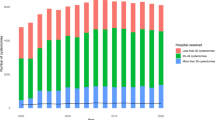Abstract
Objective
Radical cystectomy is a major surgical procedure associated with significant blood loss and lengthy hospital stays. This surgical procedure is more challenging in women than men due to anatomical-based differences. We evaluated resource utilization and complication rates of patients undergoing radical cystectomy or exenteration using the Texas Hospital In-Patient Discharge Data Collection.
Methods
This was a retrospective study of 1,493 patients, 35 years of age or older, who underwent radical cystectomy for bladder cancer from January 2000 to December 2003. We evaluated blood product charges, length of stay, and complication rates during hospitalization.
Results
In this sample, 24% of the patients (n = 356) were women. Overall, women had significantly increased blood product charges and length of stay compared to men, $1,392.87 vs. $718.21 (P < 0.001) and 12.72 vs. 11.64 (P = 0.03), respectively. During hospitalization, 26 of the patients died. No differences in mortality or complication rates were observed between men and women. Multivariate analysis showed that female sex (P < 0.001) and age (P = 0.003) were independent predictors of increased blood product charges. Multivariate analysis showed that female sex (P = 0.015), age (P = 0.003), and Charlson’s comorbidity index >1 (P = 0.05) were predictors of longer length of stay.
Conclusion
Women and older patients with bladder cancer are at risk of increased blood products utilization and length of hospital stay after a radical cystectomy. Appropriate postoperative care and referrals should improve postoperative outcomes for these vulnerable patients.
Similar content being viewed by others
Abbreviations
- ICD-9:
-
International Classification of Diseases, 9th Revision
References
Cancer facts and figures 2007. American Cancer Society, Atlanta, 2007
PDQ® (2007) National Cancer Institute, Bethesda, vol 2007
Chang SS, Cookson MS, Baumgartner RG, Wells N, Smith JA Jr (2002) Analysis of early complications after radical cystectomy: results of a collaborative care pathway. J Urol 167:2012
Chahal R, Sundaram SK, Iddenden R, Forman DF, Weston PMT, Harrison SCW (2003) A study of the morbidity, mortality and long-term survival following radical cystectomy and radical radiotherapy in the treatment of invasive bladder cancer in Yorkshire. Eur Urol 43:246
Baumgartner RG, Wells N, Chang SS, Cookson MS, Smith JA Jr (2002) Causes of increased length of stay following radical cystectomy. Urol Nurs 22:319
Hollenbeck BK, Wei Y, Birkmeyer JD (2007) Volume, process of care, and operative mortality for cystectomy for bladder cancer. Urology 69:871
Cardenas-Turanzas M, Cooksley C, Pettaway CA, Sabichi A, Grossman HB, Elting LS (2006) Comparative outcomes of bladder cancer. Obstet Gynecol 108:169
Lee KL, Freiha F, Presti JC Jr, Gill HS (2004) Gender differences in radical cystectomy: complications and blood loss. Urology 63:1095
Chang SS, Smith JA Jr, Cookson MS (2003) Decreasing blood loss in patients treated with radical cystectomy: a prospective randomizes trial using a new stapling device. J Urol 169:951
ICD-9-CM: National Center for Health Statistics
Iezzoni LI, Foley SM, Heeren T et al (1992) A method for screening the quality of hospital care using administrative data: preliminary validation results. QRB Qual Rev Bull 18:361
Elting LS, Pettaway CA, Bekele BN, Grossman HB, Cooksley C, Avritscher EB et al (2005) Correlation between annual volume of cystectomy, professional staffing, and outcomes: a statewide, population-based study. Cancer 104:975
Lawthers AG, McCarthy EP, Davis RB, Peterson LE, Palmer RH, Iezzoni LI (2000) Identification of in-hospital complications from claims data. Is it valid? Med Care 38:785
Romano PS, Chan BK, Schembri ME, Rainwater JA (2002) Can administrative data be used to compare postoperative complication rates across hospitals? Med Care 40:856
Charlson ME, Pompei P, Ales KL, MacKenzie CR (1987) A new method of classifying prognostic comorbidity in longitudinal studies: development and validation. J Chronic Dis 40:373
McCulloch C, Searle S (2001) Generalized, linear, and mixed models. John Wiley, New York, p 358
Author information
Authors and Affiliations
Corresponding author
Rights and permissions
About this article
Cite this article
Cárdenas-Turanzas, M., Cooksley, C., Kamat, A.M. et al. Gender and age differences in blood utilization and length of stay in radical cystectomy: a population-based study. Int Urol Nephrol 40, 893–899 (2008). https://doi.org/10.1007/s11255-008-9351-x
Received:
Accepted:
Published:
Issue Date:
DOI: https://doi.org/10.1007/s11255-008-9351-x




